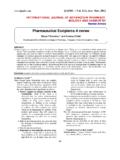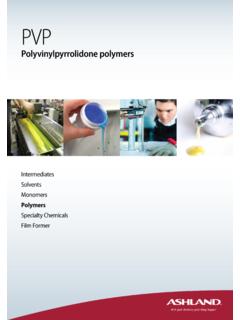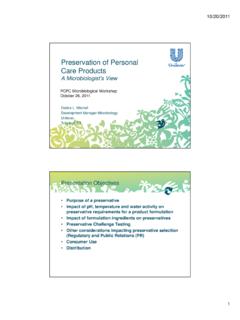Transcription of ANNEX I SUMMARY OF PRODUCT CHARACTERISTICS
1 ANNEX I. SUMMARY OF PRODUCT CHARACTERISTICS . 1. This medicinal PRODUCT is subject to additional monitoring. This will allow quick identification of new safety information. Healthcare professionals are asked to report any suspected adverse reactions. See section for how to report adverse reactions. 1. NAME OF THE MEDICINAL PRODUCT . Refixia 500 IU powder and solvent for solution for injection Refixia 1000 IU powder and solvent for solution for injection Refixia 2000 IU powder and solvent for solution for injection 2. QUALITATIVE AND QUANTITATIVE COMPOSITION. Refixia 500 IU powder and solvent for solution for injection Each vial contains nominally 500 IU nonacog beta pegol*. After reconstitution, 1 ml of Refixia contains approximately 125 IU nonacog beta pegol. Refixia 1000 IU powder and solvent for solution for injection Each vial contains nominally 1000 IU nonacog beta pegol*.
2 After reconstitution, 1 ml of Refixia contains approximately 250 IU nonacog beta pegol. Refixia 2000 IU powder and solvent for solution for injection Each vial contains nominally 2000 IU nonacog beta pegol*. After reconstitution, 1 ml of Refixia contains approximately 500 IU nonacog beta pegol. *recombinant human factor IX, produced in Chinese Hamster Ovary (CHO) cells by recombinant DNA technology, covalently conjugated to a 40 kDa polyethylene - glycol (PEG). The potency (International Units) is determined using the European Pharmacopeia one-stage clotting test. The specific activity of Refixia is approximately 152 IU/mg protein. Refixia is a purified recombinant human factor IX (rFIX) with a 40 kDa polyethylene - glycol (PEG). selectively attached to specific N-linked glycans in the rFIX activation peptide. Upon activation of Refixia, the activation peptide including the 40 kDa polyethylene - glycol moiety is cleaved off, leaving the native activated factor IX molecule.
3 The primary amino acid sequence of the rFIX in Refixia is identical to the Ala148 allelic form of human plasma-derived factor IX. No additives of human or animal origin are used in the cell culture, purification, conjugation, or formulation of Refixia. Excipient with known effect Less than 1 mmol sodium (23 mg) per vial. For the full list of excipients, see section 3. PHARMACEUTICAL FORM. Powder and solvent for solution for injection. The powder is white to off-white. The solvent is clear and colourless. pH: Osmolality: 272 mOsmol/kg. 2. 4. CLINICAL PARTICULARS. Therapeutic indications Treatment and prophylaxis of bleeding in patients 12 years and above with haemophilia B (congenital factor IX deficiency). Posology and method of administration Treatment should be under the supervision of a physician experienced in the treatment of haemophilia. Previously untreated patients The safety and efficacy of Refixia in previously untreated patients have not yet been established.
4 Treatment monitoring Routine monitoring of factor IX activity levels for the purpose of dose adjustment is not necessary. In the clinical trial programme, dose adjustment was not performed. Mean steady state factor IX trough levels above 15% were observed for all age groups, see section for details. Due to the interference of polyethylene glycol (PEG) in the one-stage clotting assay with various aPTT. reagents, it is recommended to use a chromogenic assay ( Rox Factor IX or Biophen) when monitoring is needed. If a chromogenic assay is not available, it is recommended to use a one-stage clotting assay with an aPTT reagent ( Cephascreen) qualified for use with Refixia. For modified long-acting factor products it is known that the one-stage clotting assay results are highly dependent on the aPTT reagent and reference standard used. For Refixia some reagents will cause underestimation (30 50%), while most silica containing reagents will cause severe overestimation of the factor IX activity (more than 400%).
5 Therefore, silica based reagents should be avoided. Use of a reference laboratory is recommended when a chromogenic assay or a qualified one-stage clotting assay is not available locally. Posology The number of units of factor IX administered is expressed in International Units (IU), which are related to the current WHO standard for factor IX products. Factor IX activity in plasma is expressed either as a percentage (relative to normal human plasma) or in International Units (relative to an International Standard for factor IX in plasma). Prophylaxis 40 IU/kg body weight once weekly. Adjustments of doses and administration intervals may be considered based on achieved FIX levels and individual bleeding tendency. The trough levels achieved with the weekly 40 IU/kg dosing regimen are summarised in section Patients on prophylaxis who forget a dose are advised to take their dose upon discovery and thereafter continue with the usual once weekly dosing schedule.
6 A double dose should be avoided. On-demand treatment Dose and duration of the substitution therapy depend on the location and severity of the bleeding, see Table 1 for dosing guidance in bleeding episodes. Table 1 Treatment of bleeding episodes with Refixia Degree of Recommended Dosing recommendations haemorrhage dose IU/kg of Refixia 3. Early 40 A single dose is recommended. haemarthrosis, muscle bleeding or oral bleeding. More extensive haemarthrosis, muscle bleeding or haematoma. Severe or life 80 Additional doses of 40 IU/kg can be threatening given. haemorrhages. Surgery The dose level and dosing intervals for surgery depend on the procedure and local practice. General recommendations are provided in Table 2. Table 2 Treatment in surgery with Refixia Type of surgical Recommended Dosing recommendations procedure dose IU/kg body weight Minor surgery 40 Additional doses can be given if needed.
7 Including tooth extraction. Major surgery. 80 Pre-operative dose. 40 Consider two repeated doses of 40 IU/kg (in 1 3 day intervals) within the first week after surgery. Due to the long half-life of Refixia, the frequency of dosing in the post-surgical period may be extended to once weekly after the first week until bleeding stops and healing is achieved. Paediatric population The dose recommendations in adolescents (12 18 years) are the same as for adults: 40 IU/kg body weight. The long-term safety of Refixia in children below 12 years has not yet been established. Method of administration Intravenous use. Refixia is administered by intravenous bolus injection over several minutes after reconstitution of the powder for injection with the histidine solvent. The rate of administration should be determined by the patient's comfort level up to a maximum injection rate of 4 ml/min.
8 For instructions on reconstitution of the medicinal PRODUCT before administration, see section In case of self-administration or administration by caregiver appropriate training is needed. Contraindications 4. Hypersensitivity to the active substance or to any of the excipients listed in section Known allergic reaction to hamster protein. Special warnings and precautions for use Hypersensitivity Allergic type hypersensitivity reactions are possible with Refixia. The PRODUCT contains traces of hamster proteins. If symptoms of hypersensitivity occur, patients should be advised to discontinue use of the medicinal PRODUCT immediately and contact their physician. Patients should be informed of the early signs of hypersensitivity reactions including hives, generalised urticaria, tightness of the chest, wheezing, hypotension, and anaphylaxis. In case of shock, standard medical treatment for shock should be implemented.
9 Inhibitors After repeated treatment with human coagulation factor IX (rDNA) products, patients should be monitored for the development of neutralising antibodies (inhibitors) that should be quantified in Bethesda Units (BU) using appropriate biological testing. There have been reports in the literature showing a correlation between the occurrence of a factor IX. inhibitor and allergic reactions. Therefore, patients experiencing allergic reactions should be evaluated for the presence of an inhibitor. It should be noted that patients with factor IX inhibitors may be at an increased risk of anaphylaxis with subsequent challenge with factor IX. Because of the risk of allergic reactions with factor IX products, the initial administrations of factor IX. should, according to the treating physician's judgement, be performed under medical observation where proper medical care for allergic reactions could be provided.
10 In case of residual FIX activity levels, there is a risk of interference when performing the Nijmegen modified Bethesda assay for inhibitor testing. Therefore a pre-heating step or a wash-out is recommended in order to ensure detection of low-titre inhibitors. Thromboembolism Because of the potential risk of thrombotic complications, clinical surveillance for early signs of thrombotic and consumptive coagulopathy should be initiated with appropriate biological testing when administering this PRODUCT to patients with liver disease, to patients post-operatively, to new-born infants, or to patients at risk of thrombotic phenomena or DIC. In each of these situations, the benefit of treatment with Refixia should be weighed against the risk of these complications. Cardiovascular event In patients with existing cardiovascular risk factors, substitution therapy with FIX may increase the cardiovascular risk.
















